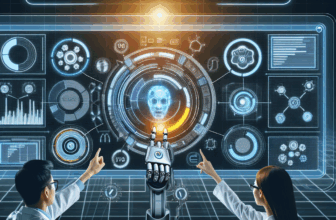Maximizing Revenue with Smart Strategies: The Benefits of AI-Powered Automated Upselling and Cross-Selling
Table of Contents
- 1. Understanding Upselling and Cross-Selling
- 2. The Role of AI in Upselling and Cross-Selling
- 3. Benefits of AI-Powered Automated Strategies
- 4. Implementing AI for Upselling and Cross-Selling
- 5. Real-Life Case Studies
- 6. Challenges and Solutions
- 7. Future Trends in AI-Powered Sales Strategies
- 8. Conclusion
1. Understanding Upselling and Cross-Selling
Upselling and cross-selling are pivotal strategies in the modern sales landscape. Understanding these concepts is essential for businesses aiming to maximize revenue.
1.1 What is Upselling?
Upselling refers to the practice of encouraging customers to purchase a more expensive item, an upgrade, or an add-on to enhance their original purchase. This technique is prevalent in various industries, including retail, hospitality, and e-commerce.
1.2 What is Cross-Selling?
Cross-selling, on the other hand, involves offering customers complementary products or services related to their initial purchase. For example, suggesting a phone case when a customer buys a smartphone.
1.3 Key Differences Between Upselling and Cross-Selling
The critical distinction lies in the focus of each strategy: upselling aims for higher-value purchases, whereas cross-selling targets additional purchases unrelated to the main item.
1.4 Importance of These Strategies
Both strategies are vital for maximizing customer lifetime value (CLV) by enhancing the overall shopping experience, which can lead to increased loyalty and repeat purchase behavior.
2. The Role of AI in Upselling and Cross-Selling
Artificial Intelligence (AI) has revolutionized various industries, and sales strategies are no exception. AI enables businesses to implement highly effective upselling and cross-selling strategies that were previously impossible.
2.1 Personalization with AI
One of the most significant advantages of using AI in sales is the ability to personalize the shopping experience. AI analyzes customer data to understand preferences and behaviors, enabling targeted promotions and recommendations.
2.2 Predictive Analytics
Predictive analytics uses historical data to forecast future behaviors. In the context of upselling and cross-selling, AI analyzes past purchase behaviors to identify which products are most likely to be purchased together.
2.3 Customer Segmentation
AI allows for intricate customer segmentation based on demographics, purchasing history, and browsing behavior. This segmentation aids businesses in tailoring offers that resonate more effectively with different customer groups.
3. Benefits of AI-Powered Automated Strategies
Implementing AI-powered upselling and cross-selling strategies offers numerous benefits. These advantages transcend traditional sales techniques.
3.1 Increased Revenue
AI-powered strategies can significantly boost revenue by promoting products effectively based on customer preferences, leading to higher conversion rates.
3.2 Enhanced Customer Experience
A personalized shopping experience fosters customer satisfaction and loyalty. Customers are more likely to return if they feel understood and valued.
3.3 Operational Efficiency
Automation reduces the need for manual work in identifying upselling and cross-selling opportunities, allowing teams to focus on strategic initiatives and personal engagement.
3.4 Improved Inventory Management
AI can also aid in optimizing inventory by providing insights into products that pair well together, helping businesses manage stock levels more effectively.
4. Implementing AI for Upselling and Cross-Selling
Successfully integrating AI into business operations requires strategic planning and execution. This section outlines critical steps for businesses to adopt AI-powered upselling and cross-selling.
4.1 Selecting the Right AI Tools
Choosing the appropriate AI tools is essential for successful implementation. Factors to consider include the tool’s scalability, integration capabilities, and user-friendliness.
4.2 Data Collection and Analysis
Data is at the heart of AI-driven sales strategies. Businesses must gather comprehensive customer data to enable accurate analysis and personalized offerings.
4.3 Developing a Customer Journey Map
Mapping the customer journey is crucial for identifying key touchpoints where upselling and cross-selling can occur. During different stages, customers respond uniquely to suggestions based on their needs.
4.4 Training Staff and Stakeholders
Employees and stakeholders must be trained on the new tools and strategies to ensure seamless implementation. Understanding how to leverage AI insights is vital for maximizing results.
5. Real-Life Case Studies
Case studies illustrate the effectiveness of AI-powered upselling and cross-selling strategies in real-world scenarios. Various companies have successfully harnessed these strategies.
5.1 Amazon’s Recommendation Engine
Amazon’s recommendation engine is a classic example of effective cross-selling. By employing AI algorithms, Amazon suggests products based on users’ browsing and purchase history, resulting in significant revenue increases.
5.2 Spotify’s Personalized Playlists
Spotify utilizes AI to curate personalized playlists for its users. By analyzing listening habits, Spotify can cross-sell albums and concert tickets, enhancing user engagement and satisfaction.
5.3 Netflix’s Viewing Recommendations
Netflix’s AI-driven recommendation system helps retain subscribers by suggesting shows and movies based on individual viewing habits, demonstrating the power of personalization in retaining customers.
6. Challenges and Solutions
While the benefits of AI-powered upselling and cross-selling are significant, businesses may encounter challenges during implementation. This section delves into common issues and potential solutions.
6.1 Data Privacy Concerns
With increasing scrutiny on data privacy, businesses must navigate regulatory landscapes while implementing AI. Solutions include adopting robust data protection protocols and being transparent with customers about data usage.
6.2 Integration with Existing Systems
Integrating AI solutions with current technology can be challenging. Businesses should opt for tools that streamline integration and offer comprehensive support during the transition.
6.3 Maintaining Human Touch
Automation can often feel impersonal. Balancing AI-driven strategies with personalized customer service remains crucial for fostering trust and loyalty.
7. Future Trends in AI-Powered Sales Strategies
The landscape of AI in sales is continuously evolving. This section explores emerging trends that businesses should watch for in the upcoming years.
7.1 Integration of Augmented Reality (AR)
As AR technology advances, businesses could utilize it in upselling and cross-selling. For instance, customers could visualize how products fit into their lives, enhancing the buying experience.
7.2 Enhanced Voice and Chat Interfaces
With the growth of smart assistants and chatbots, businesses can leverage these platforms for upselling and cross-selling in real-time conversations, offering a seamless shopping experience.
7.3 Advanced Predictive Analytics
Future advancements in AI will lead to even more refined predictive analytics, allowing businesses to anticipate customer needs better and tailor their offerings accordingly.
8. Conclusion
AI-powered automated upselling and cross-selling strategies represent a transformative opportunity for businesses in today's digital landscape. By embracing these innovative strategies, companies can maximize revenues and enhance customer satisfaction.
The ongoing integration of AI into sales processes promises exciting opportunities for businesses willing to adapt and evolve. Future advancements will likely enhance the ways customers interact with brands, creating more personalized and meaningful connections.
Q&A Section
Q: What are the main differences between upselling and cross-selling?
A: Upselling encourages customers to purchase a more expensive item or upgrade, while cross-selling suggests complementary products related to the original purchase.
Q: How can AI improve my business's upselling and cross-selling efforts?
A: AI can analyze customer data to provide personalized recommendations, segment customers effectively, and utilize predictive analytics to anticipate customer preferences, ultimately improving conversion rates.
FAQ
- What industries benefit the most from AI-powered upselling and cross-selling?
While many industries can benefit, e-commerce, retail, and hospitality see substantial gains due to their reliance on customer experience and repeat purchases.
- What are some common AI tools for upselling and cross-selling?
Common AI tools include recommendation engines, customer relationship management (CRM) systems with AI functionalities, and predictive analytics platforms.
Resources
| Source | Description | Link |
|---|---|---|
| HubSpot | Insights on upselling and cross-selling strategies in marketing. | Visit HubSpot |
| Mckinsey & Company | Research on the impact of AI on sales optimization strategies. | Visit McKinsey |
| Forbes | Articles about AI trends in business and sales strategies. | Visit Forbes |
| Gartner | Reports on customer engagement and AI tools. | Visit Gartner |
Disclaimer: This article is produced by A.I. and is in Beta Testing. The content herein is intended to provide informative insights into maximizing revenue through AI-powered strategies. While every effort is made to ensure the information is accurate and up-to-date, it is essential to conduct further research and evaluations based on specific business needs.










